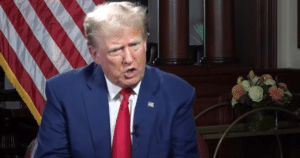White House faces scrutiny over Trump's evolving stance on Project 2025
Hold onto your hats, folks—President Donald Trump’s dance with Project 2025 has taken a sharp turn, and the White House is scrambling to explain the steps. The controversial policy proposal from the Heritage Foundation, once dismissed by Trump as unfamiliar territory, is now at the center of heated discussions about government cuts during the ongoing shutdown. And with whispers of federal layoffs and paused projects, the administration’s latest moves are raising eyebrows.
Let’s break it down: the White House is under fire as Trump’s position on Project 2025—a sprawling conservative policy document—seems to shift amid a government shutdown, with questions swirling about whether it’s the roadmap for slashing federal programs and jobs.
Back in July, Trump was crystal clear about Project 2025, a nearly thousand-page plan crafted by the Heritage Foundation. He publicly distanced himself, claiming ignorance about its creators and rejecting some of its ideas as outlandish. But fast forward to now, and the tune sounds different.
Trump's Sudden Connection to Project 2025
On Thursday, Trump took to Truth Social with a post that dropped jaws, announcing a meeting with Russell Vought, a central figure behind Project 2025 and current head of the Office of Management and Budget. “I have a meeting today with Russ Vought, he of PROJECT 2025 Fame, to determine which of the many Democrat Agencies… he recommends to be cut,” Trump wrote. Well, isn’t that a plot twist worth a second look?
Critics pounced on this revelation, reigniting their disdain for Project 2025, which Democrats have long branded as a dangerous set of policies spanning everything from economic reforms to social issues. The Harris-Walz campaign, in particular, has been vocal about its objections. But let’s be fair—disagreement is the spice of democracy, even if some ideas seem more half-baked than others.
By Friday, the White House press room was buzzing as Fox News correspondent Peter Doocy pressed Press Secretary Karoline Leavitt on Trump’s apparent about-face. “During the campaign, President Trump said that he did not know anything about Project 2025. Now, he knows about it. Is that the blueprint for shrinking the government?” Doocy asked. Talk about putting someone on the hot seat!
White House Dodges Direct Answers
Leavitt, however, played it coy, sidestepping the specifics of Project 2025 and instead emphasizing that decisions on cuts and layoffs rest with Trump, his team, and Cabinet secretaries. It’s a classic non-answer, but perhaps a reminder that the devil’s always in the details. Or, in this case, the thousand-page policy binder.
Instead of diving into the document, Leavitt pointed to a tangible example of government spending on pause: a whopping $2.1 billion in Chicago infrastructure projects. “We paused $2.1 billion in Chicago infrastructure projects… because the administration is concerned that the Biden administration was handing out taxpayer dollars… based on DEI,” she explained. Turns out, fiscal restraint can come with a side of ideological critique.
She elaborated that the Department of Transportation is scrutinizing these projects—specifically the Red Line extension and Red and Purple modernization efforts—for what they call race-based contracting practices deemed unconstitutional. “The Department of Transportation funds for these projects are on hold,” Leavitt added. If you’re wondering about waste in government, this might just be exhibit A.
Shutdown Fuels Cuts and Criticism
The timing couldn’t be more tense, as these discussions unfold during a government shutdown, with Trump and the OMB hashing out potential layoffs and program reductions. It’s no secret that shrinking government bloat is a rallying cry for many conservatives. But the question remains—how much is too much when essential services hang in the balance?
Project 2025, for all its polarizing content, has become a lightning rod in this debate over federal overreach. Critics on the left see it as a wrecking ball to progressive gains, while supporters might argue it’s a long-overdue pruning of bureaucratic excess. Both sides have a point, but only one can steer the ship.
Trump’s earlier dismissal of the project as something he barely knew now contrasts sharply with his public embrace of a key architect like Vought. Actions, as they say, speak louder than campaign soundbites. And meeting with the mastermind of a plan you once disavowed? That’s a headline all its own.
What’s Next for Federal Spending?
Leavitt’s comments suggest the administration is laser-focused on rooting out what they see as wasteful or ideologically driven spending, like the paused Chicago projects. It’s a bold stance, especially when infrastructure often enjoys bipartisan support. But when taxpayer dollars are tied to controversial policies, expect pushback from all corners.
As the shutdown drags on, the White House will likely face more grilling over whether Project 2025 is guiding their knife as they carve up federal budgets. For conservatives tired of unchecked government growth, this might be a refreshing change of pace. Yet, for those reliant on public programs, the uncertainty stings.
So, where does this leave us? With Trump’s evolving relationship with Project 2025 under the microscope, and billions in projects on hold, the administration has some explaining to do. One thing’s for sure—navigating a shutdown while redefining government priorities is a tightrope walk, and every step will be watched.




